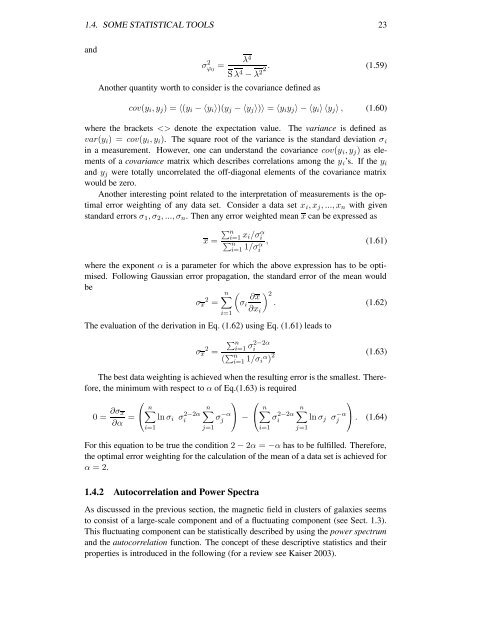Investigations of Faraday Rotation Maps of Extended Radio Sources ...
Investigations of Faraday Rotation Maps of Extended Radio Sources ...
Investigations of Faraday Rotation Maps of Extended Radio Sources ...
You also want an ePaper? Increase the reach of your titles
YUMPU automatically turns print PDFs into web optimized ePapers that Google loves.
1.4. SOME STATISTICAL TOOLS 23<br />
and<br />
σ 2 ϕ 0<br />
=<br />
λ 4<br />
. (1.59)<br />
S λ 4 − λ22 Another quantity worth to consider is the covariance defined as<br />
cov(y i , y j ) = 〈(y i − 〈y i 〉)(y j − 〈y j 〉)〉 = 〈y i y j 〉 − 〈y i 〉 〈y j 〉 , (1.60)<br />
where the brackets denote the expectation value. The variance is defined as<br />
var(y i ) = cov(y i , y i ). The square root <strong>of</strong> the variance is the standard deviation σ i<br />
in a measurement. However, one can understand the covariance cov(y i , y j ) as elements<br />
<strong>of</strong> a covariance matrix which describes correlations among the y i ’s. If the y i<br />
and y j were totally uncorrelated the <strong>of</strong>f-diagonal elements <strong>of</strong> the covariance matrix<br />
would be zero.<br />
Another interesting point related to the interpretation <strong>of</strong> measurements is the optimal<br />
error weighting <strong>of</strong> any data set. Consider a data set x i , x j , ..., x n with given<br />
standard errors σ 1 , σ 2 , ..., σ n . Then any error weighted mean x can be expressed as<br />
x =<br />
∑ ni=1<br />
x i /σ α i<br />
∑ ni=1<br />
1/σ α i<br />
, (1.61)<br />
where the exponent α is a parameter for which the above expression has to be optimised.<br />
Following Gaussian error propagation, the standard error <strong>of</strong> the mean would<br />
be<br />
n∑<br />
( )<br />
σ 2 ∂x 2<br />
x = σ i . (1.62)<br />
∂x i<br />
The evaluation <strong>of</strong> the derivation in Eq. (1.62) using Eq. (1.61) leads to<br />
σ x 2 =<br />
i=1<br />
∑ ni=1<br />
σ 2−2α<br />
i<br />
( ∑ n<br />
i=1 1/σ i α ) 2 (1.63)<br />
The best data weighting is achieved when the resulting error is the smallest. Therefore,<br />
the minimum with respect to α <strong>of</strong> Eq.(1.63) is required<br />
⎛<br />
0 = ∂σ x<br />
∂α = ⎝<br />
n∑<br />
i=1<br />
ln σ i σ 2−2α<br />
i<br />
n∑<br />
j=1<br />
σ −α<br />
j<br />
⎞ ⎛<br />
n∑<br />
⎠ − ⎝<br />
i=1<br />
σ 2−2α<br />
i<br />
⎞<br />
n∑<br />
ln σ j σj<br />
−α<br />
j=1<br />
⎠ . (1.64)<br />
For this equation to be true the condition 2 − 2α = −α has to be fulfilled. Therefore,<br />
the optimal error weighting for the calculation <strong>of</strong> the mean <strong>of</strong> a data set is achieved for<br />
α = 2.<br />
1.4.2 Autocorrelation and Power Spectra<br />
As discussed in the previous section, the magnetic field in clusters <strong>of</strong> galaxies seems<br />
to consist <strong>of</strong> a large-scale component and <strong>of</strong> a fluctuating component (see Sect. 1.3).<br />
This fluctuating component can be statistically described by using the power spectrum<br />
and the autocorrelation function. The concept <strong>of</strong> these descriptive statistics and their<br />
properties is introduced in the following (for a review see Kaiser 2003).
















